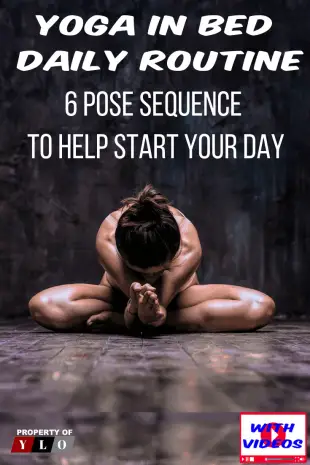Start your day off right with 6 Morning Yoga Poses You Can Do in Bed. Many people are surprised to learn that there are yoga poses you can do in bed. Not everyone is a morning person, and yoga is a great way to get yourself up and moving.
Are You A Morning Yoga Person?
It is well-established that practicing yoga benefits both mind and body. Yoga can calm and clear your mind, which can improve your mood, and leave you feeling ready to conquer the world.
It can also jump start healthy breathing and digestion, and can even ease aches and pains and help prevent bodily injury throughout your day. Even before you get out of bed, you can enjoy these plentiful benefits of yoga.
To be honest, you could do these poses in bed before you retire for the night. That way you would get a better nights sleep. However, for this post, we are concentrating on Morning Yoga.
Morning Yoga for Your Mind
The mental benefits of yoga might not be the most well-known. Many people know of the physical benefits, but yoga really can provide peace of mind as well.
Part of the practice of yoga involves meditation, which utilizes deep concentration and reflection and can help sharpen your mind. The meditation commonly practiced with yoga aims to calm your thoughts and refocus your priorities.
Starting your day with a relaxed, positive outlook can make those early mornings much easier to face.

Morning Yoga for Your Breathing
Practicing the deep breathing techniques associated with yoga first thing in the morning, and on a daily basis, can lead to the development of a very healthy habit. In the short-term, deep breathing results in relaxation, less stress and even pain reduction.
One long-term benefit is improved circulation, which results when deep breathing dilates your blood vessels. Yoga breathing techniques can even stabilize your blood pressure over the long-term as well.
Morning Yoga for Your Digestion
The bending and folding involved in many yoga poses can stimulate your internal organs and give your digestive system a boost. Additionally, yoga poses that involve twisting your midsection will gently massage your liver, stimulating its metabolism of fats.
Certain poses that you can do lying down are even specifically designed to help release trapped abdominal gasses. It is generally best to practice yoga before meals rather than after meals, which is another great reason to try these morning yoga poses you can do in bed, first thing.

Morning Yoga for Your Joints
Morning Yoga postures can also keep you flexible and strong. Certain poses focus specifically on skeletal alignment.
Proper alignment can minimize joint pain throughout the day. Yoga also improves flexibility, which can likewise help keep the pain away.
Postures that strengthen the muscles that surround joints lead to improved skeletal support, which can take excess pressure off those joints. Your joints will thank you for practicing morning yoga.
Create New Habits
If you roll out of bed and rush through your morning, it may be unrealistic to expect a smooth start to your day. By creating a daily routine of morning yoga to start your day, you will develop a very healthy habit.
Nurturing your mind-body connection can help fend off unhealthy temptations. When your body feels better, you feel better, and you may find yourself nourishing your body a little more thoughtfully.
Setting your alarm clock for just a little earlier each day to make time for this morning yoga pose routine, will reap rewards you will thank yourself for later!
With these morning yoga poses you will noticeably improve your mind, body, and overall quality of life.

1: Child’s Pose
Kneel on the floor. Touch your big toes together and sit on your heels, then separate your knees about as wide as your hips.
2. Exhale and lay your torso down between your thighs. Broaden your sacrum across the back of your pelvis and narrow your hip points toward the navel, so that they nestle down onto the inner thighs. Lengthen your tailbone away from the back of the pelvis while you lift the base of your skull away from the back of your neck.
3. Lay your hands on the floor alongside your torso, palms up, and release the fronts of your shoulders toward the floor. Feel how the weight of the front shoulders pulls the shoulder blades wide across your back.
4. Balasana is a resting pose. Stay anywhere from 30 seconds to a few minutes. Beginners can also use Balasana to get a taste of a deep forward bend, where the torso rests on the thighs. Stay in the pose from 1 to 3 minutes.
To come up, first, lengthen the front torso, and then with an inhalation lift from the tailbone as it presses down and into the pelvis.
2: Cat and Cow Pose
1. Start on your hands and knees with your wrists directly under your shoulders, and your knees directly under your hips. Point your fingertips to the top of your mat. Place your shins and knees hip-width apart. Center your head in a neutral position and soften your gaze downward.
2. Begin by moving into Cow Pose: Inhale as you drop your belly towards the mat. Lift your chin and chest, and gaze up toward the ceiling.
3. Broaden across your shoulder blades and draw your shoulders away from your ears.
4. Next, move into Cat Pose: As you exhale, draw your belly to your spine and round your back toward the ceiling. The pose should look like a cat stretching its back.
5. Release the crown of your head toward the floor, but don’t force your chin to your chest.
6. Inhale, coming back into Cow Pose, and then exhale as you return to Cat Pose.
3: Seated Forward Fold
1. From Staff pose, inhale the arms up over the head and lift and lengthen up through the fingers and crown of the head.
2. Exhale and hinge at the hips, slowly lower the torso towards the legs. Reach the hands to the toes, feet or ankles.
3. To deepen the stretch: A) Use the arms to gently pull the head and torso closer to the legs. B) Press out through the heels and gently draw the toes towards you.
4. Breathe and hold for 3-8 breaths.
To release:
A) Slowly roll up the spine back into Staff pose.
B) Inhale the arms back over your head as you lift the torso back into Staff pose.
4: Mountain Pose
1. Stand with the bases of your big toes touching, heels slightly apart (so that your second toes are parallel). Lift and spread your toes and the balls of your feet, then lay them softly down on the floor. Rock back and forth and side to side. Gradually reduce this swaying to a standstill, with your weight balanced evenly on the feet.
2. Firm your thigh muscles and lift the kneecaps, without hardening your lower belly. Lift the inner ankles to strengthen the inner arches, then imagine a line of energy all the way up along your inner thighs to your groins, and from there through the core of your torso, neck, and head, and out through the crown of your head. Turn the upper thighs slightly inward. Lengthen your tailbone toward the floor and lift the pubis toward the navel.
3. Press your shoulder blades into your back, then widen them across and release them down your back. Without pushing your lower front ribs forward, lift the top of your sternum straight toward the ceiling. Widen your collarbones. Hang your arms beside the torso.
4. Balance the crown of your head directly over the center of your pelvis, with the underside of your chin parallel to the floor, throat soft, and the tongue wide and flat on the floor of your mouth. Soften your eyes.
5. Tadasana is usually the starting position for all the standing poses. But it’s useful to practice Tadasana as a pose in itself.
Stay in the pose for 30 seconds to 1 minute, breathing easily.
5: Seated Pose (or Seated Lotus)
1. Sit on the floor with your legs extended, spine straight, and arms resting at your sides. This is Seated Staff Pose (Dandasana).
2. Bend your right knee and hug it to your chest. Then, bring your right ankle to the crease of your left hip so the sole of your right foot faces the sky. The top of your foot should rest on your hip crease.
3. Then, bend your left knee. Cross your left ankle over the top of your right shin. The sole of your left foot should also face upwards, and the top of your foot and ankle should rest on your hip crease.
4. Draw your knees as close together as possible. Press your groins toward the floor and sit up straight.
6: Spinal Twist
1. Lying on your back, bring your arms out to the sides with the palms facing down in a T position. Bend the right knee and place the right foot on the left knee.
2. Exhale drop the right knee over to the left side of your body, twisting the spine and low back. Look at the right fingertips.
3. Keep the shoulders flat to the floor, close the eyes, and relax into the posture. Let gravity pull the knee down, so you do not have to use any effort in this posture.
4. Breathe and hold for 6-10 breaths.
To release: inhale and roll the hips back to the floor, and exhale the leg back down to the floor.
Now you are ready to start. Review the instructions but be sure and watch the video demonstrations.
Get up and have your healthy breakfast with healthy fat and fiber, you can never go wrong incorporating avocado into any meal. Get a nice shower and prepare for your day.
This should be a morning ritual for you. This program only takes a few minutes each morning and will be the first stepping stone to a better day.
A helpful article by WebMD: Stop Finding Excuses to Avoid Yoga



